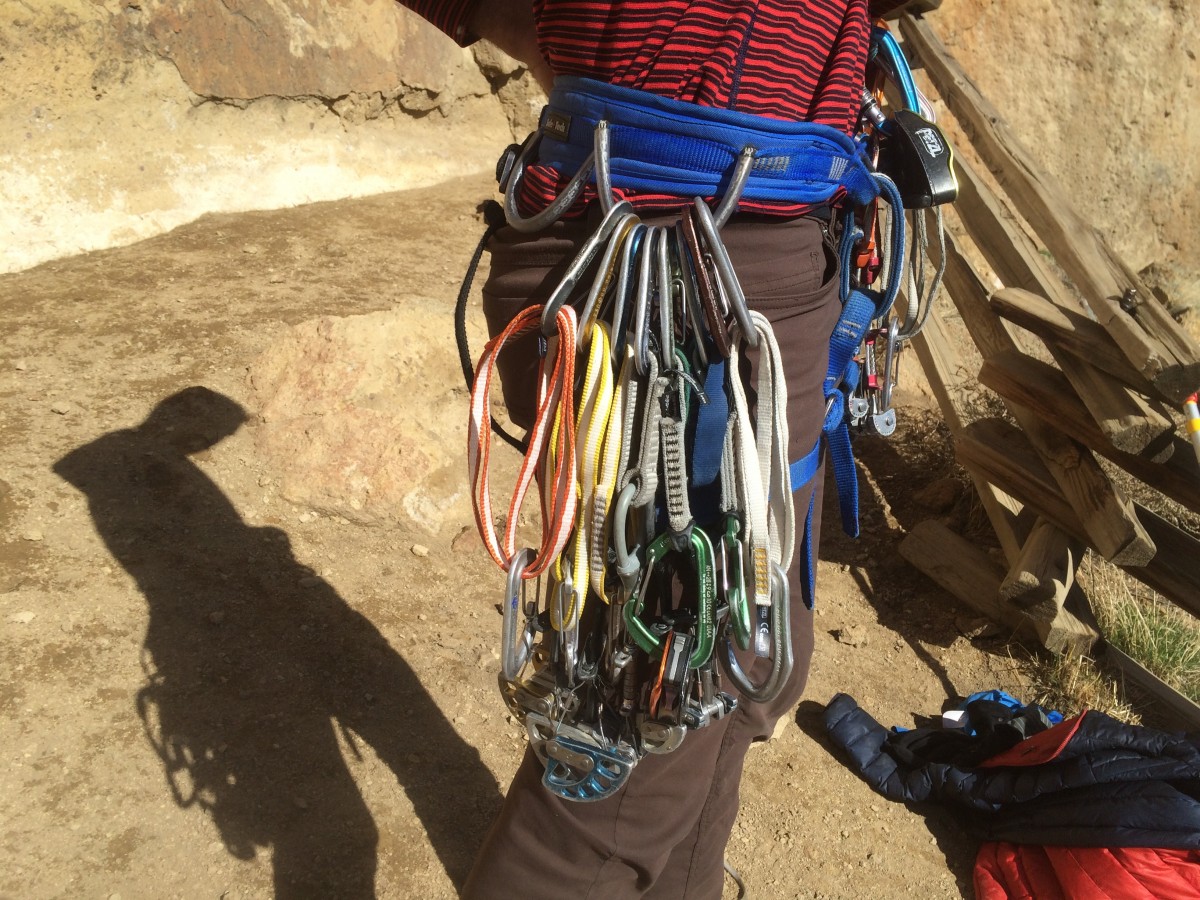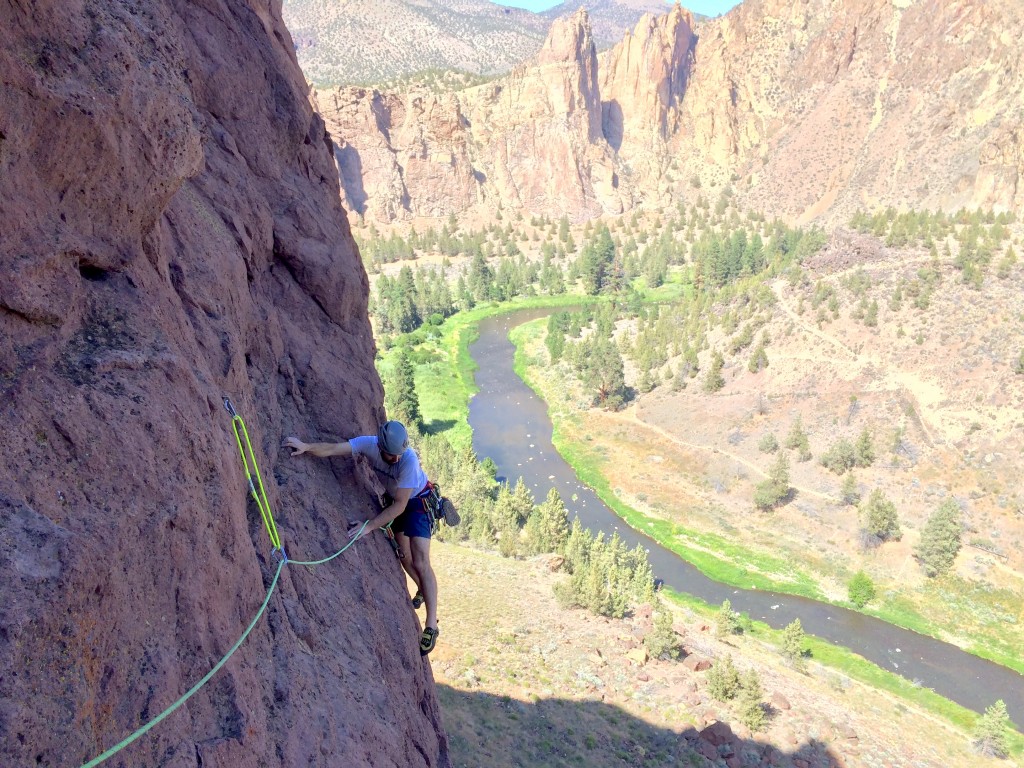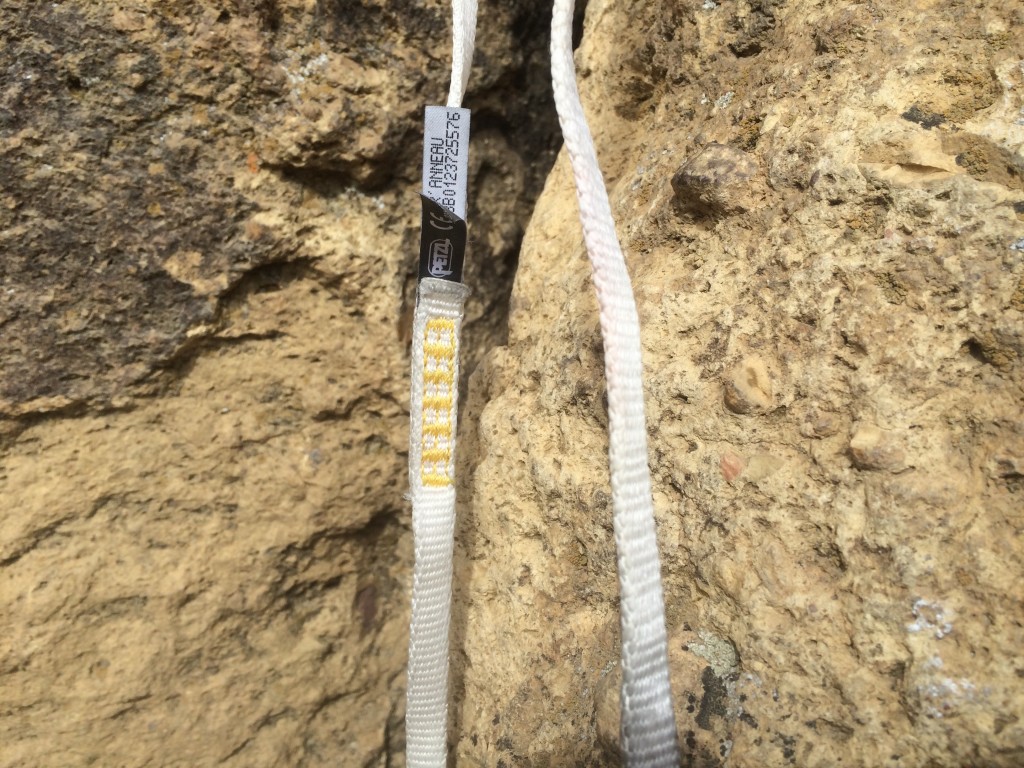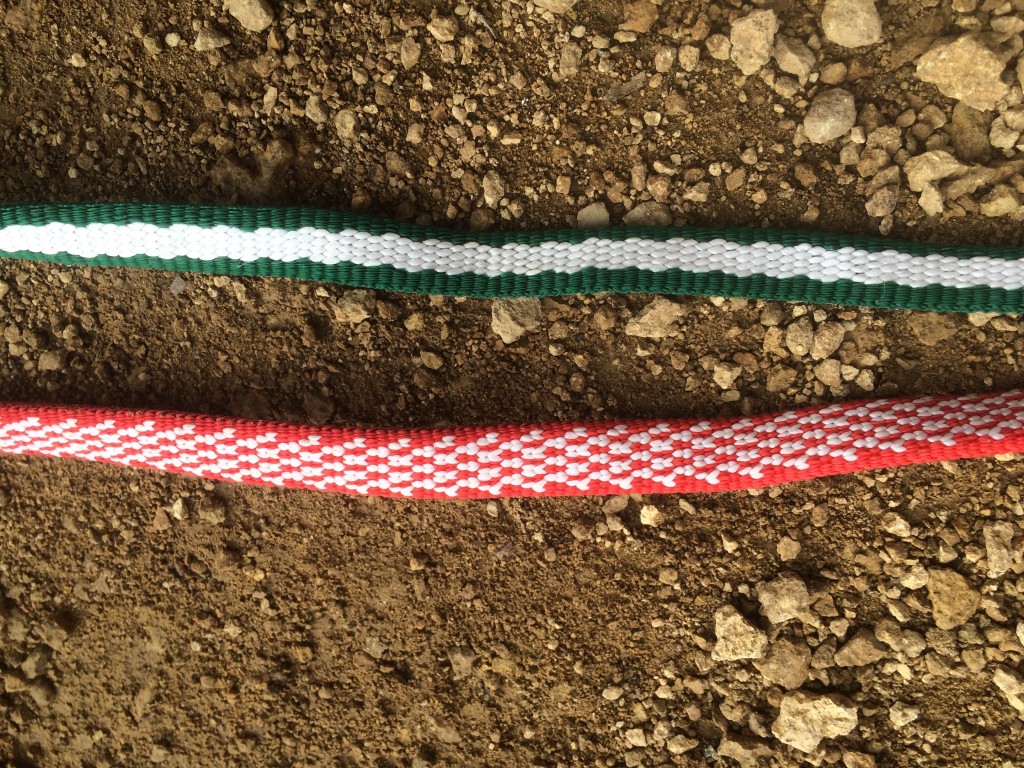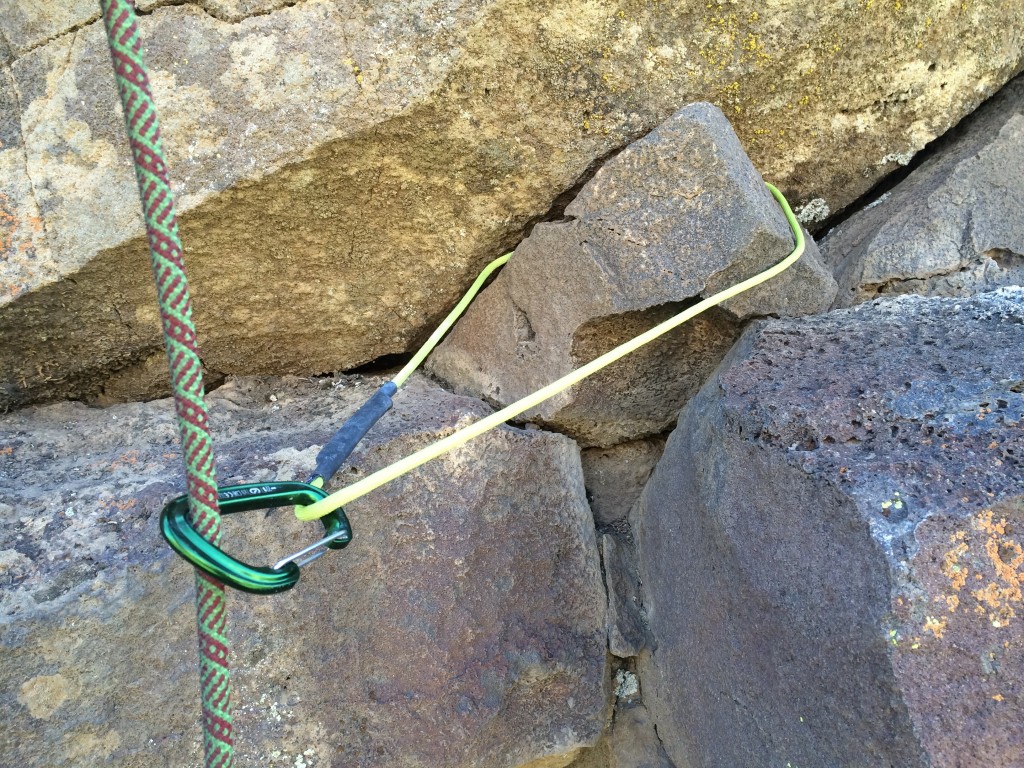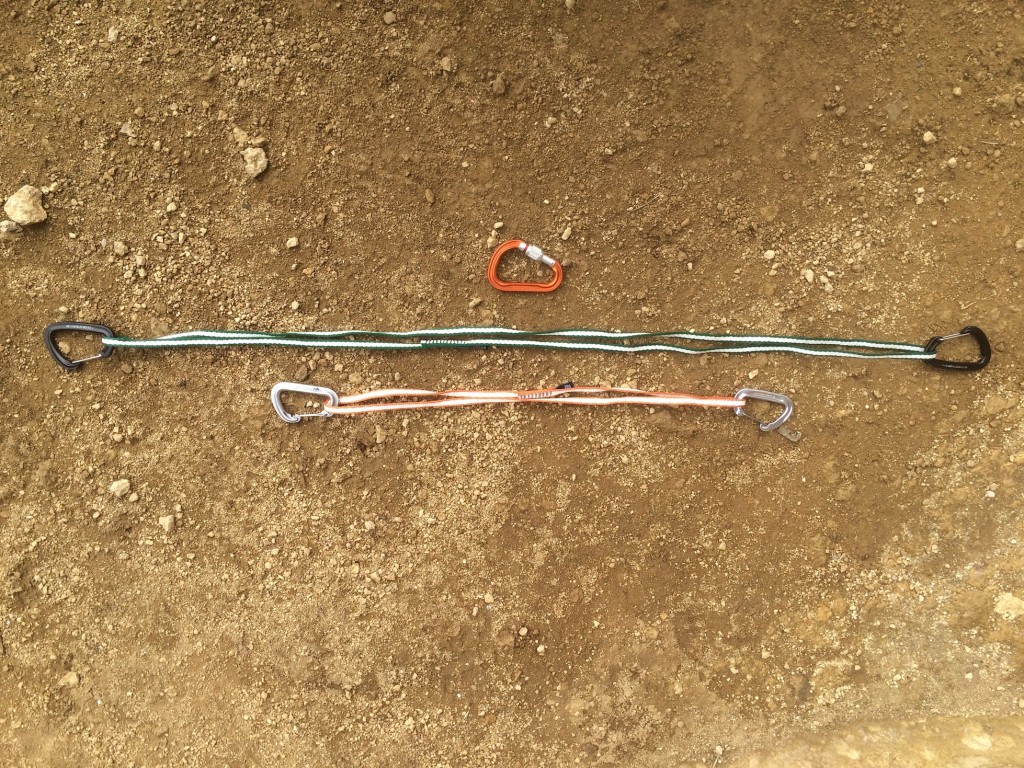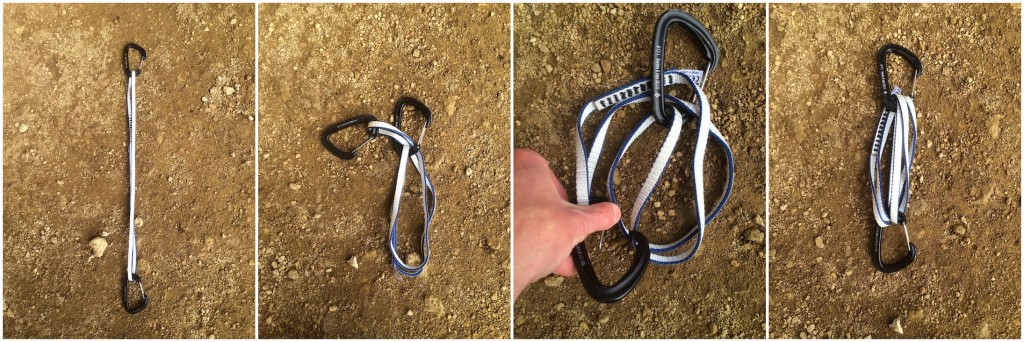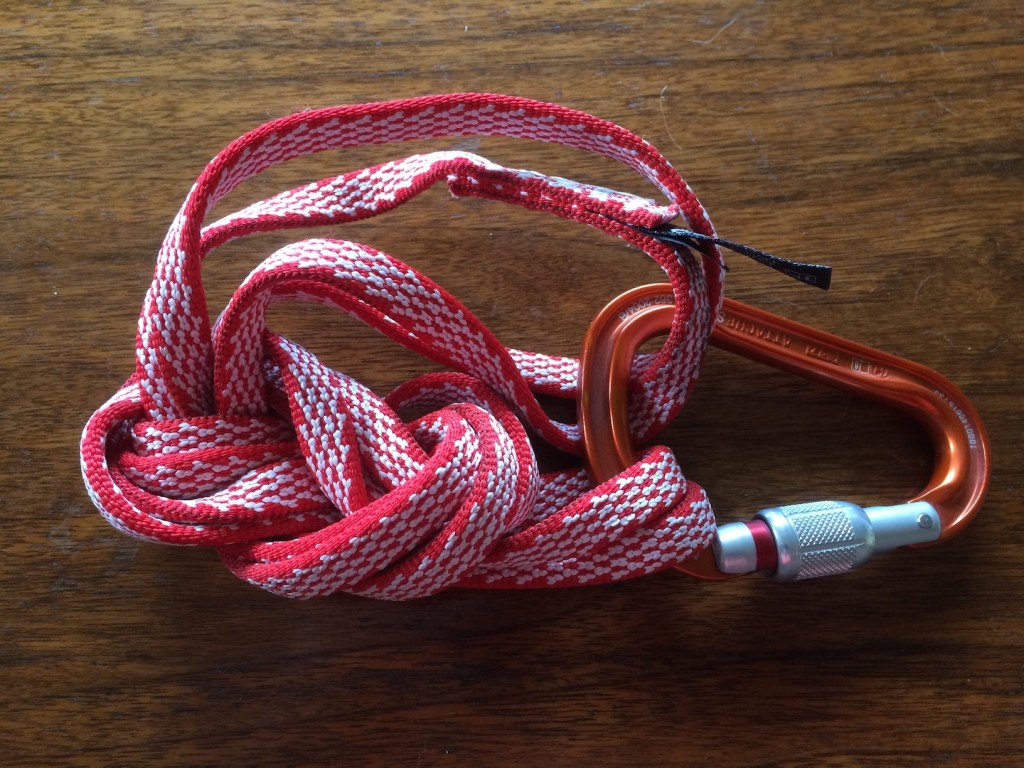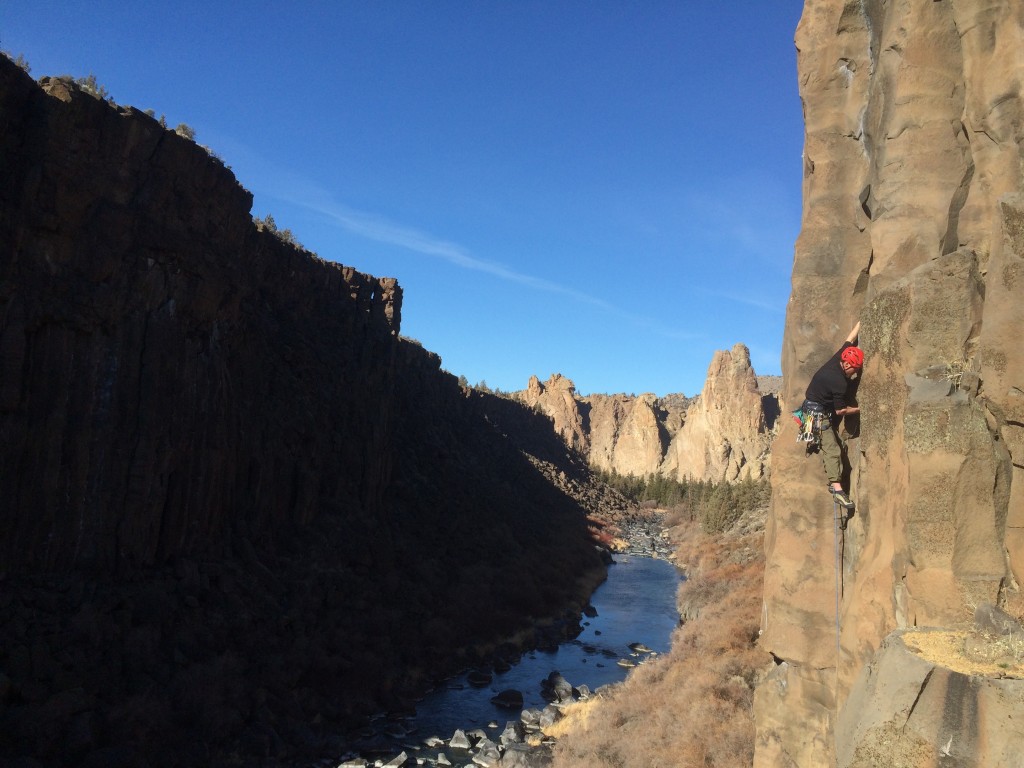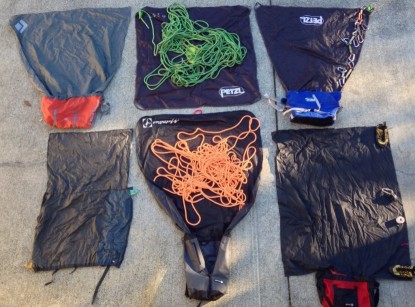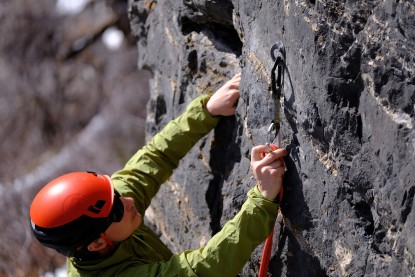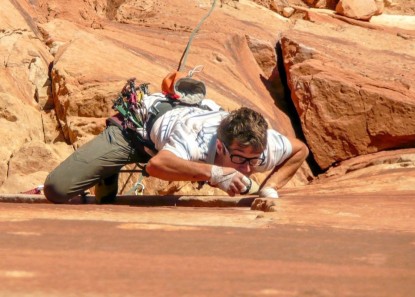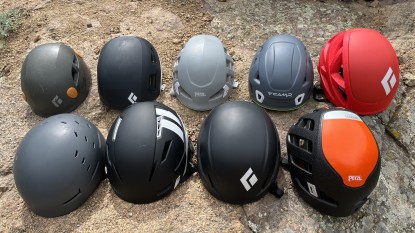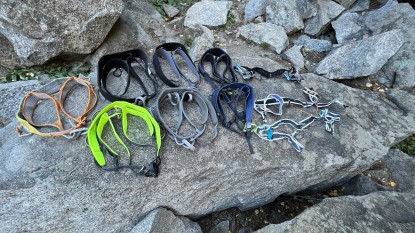Choosing the right climbing sling can be a difficult process. There are so many different choices, and in many cases, very few differences between products. In this article, we aim to help you narrow down your choices. We will walk you through the differences between fiber choices, strength ratings, lengths, and modes of carry, suggesting different products for different desires along the way.
Why Do You Need Climbing Slings?
Slings are an invaluable piece of equipment for the traditional and multi-pitch climber. The most common use of slings is while leading trad pitches, where you must place protection wherever you can find it, which may not be in a perfectly straight line. To reduce the friction, or drag, created by the rope as it runs through each piece of protection, you want the rope running in as straight of a line as possible. To help with this, leaders extend certain pieces with a sling. On pitches with large traverses or especially with roofs, or on very long pitches, using slings judiciously can be the difference between sending a pitch, or being literally halted in your tracks, trapped by the friction of the rope that hangs below you. Slings that are tripled up in an alpine quickdraw are the most versatile way of clipping the rope to passive protection, such as stoppers, hexes, or tri-cams, although quickdraws also work for this purpose, they just aren't as long. Double-length slings are most common for these purposes.
The second most common use for slings is for equalizing multiple pieces of protection in order to create a belay anchor. Regardless of how many protection points make up your anchor, it is highly recommended that these pieces be equalized, so any weight and force is spread evenly between them. Quadruple length runners, or longer, are a common mode of doing this, by clipping into each piece and then tying an equalizing figure-eight on a bight knot, which becomes the master point that everything can become clipped into. Of course, there are many other ways of equalizing a belay, and different types of equipment besides slings that can help, but slings are one of the most common ways.
Slings are sometimes used as protection themselves, by wrapping them around horns, flakes, or chicken heads. They can also be threaded through holes created by pockets, or around columns made in limestone, or ice, or wrapped around trees.
Slings can be used to tether oneself to a piece of protection or the anchor. This is common while multi-pitch climbing and changing over the lead or belay, or while rappelling as you move downwards from one station to another. A Personal Anchor System (PAS) is one form of sling designed expressly for this purpose, although not reviewed here. Another is the daisy chain, commonly used by aid climbers as they ascend big walls. Using slings that allow for dynamic stretch, such as the Beal Dynamic Sling, is advised for these uses.
Lastly, slings can be used for racking quickdraws, cams, or other gear. Generally, one uses an old, worn-out sling for this purpose, rather than buying a new one.
Types of Fibers
In general, climbing slings these days are made of two different types of fibers: Dyneema (or another type of Ultra-High-Molecular-Weight Polyethelene), and Nylon. A few slings are also made of a blend between the two types of fibers. There is a third type of sling, made of cord similar to a climbing rope. Which type you choose to buy depends on how much you want to spend, as well as what properties you value the most in your slings. Below we discuss the differences.
Dyneema / Spectra / Dynex / Polyethelene
Dyneema, Spectra, and Dynex are brand names for Ultra-High-Molecular-Weight Polyethelene fibers, also known as High-Modulus Polyethelene. While there may be very minor differences between the different brands of fibers, functionally they are virtually the same thing. These are the strongest fibers in the world, exhibiting strength to weight characteristics that far exceed steel. These fibers are made by spinning a thermoplastic gel and cooling it to make threads. This process allows for long molecular chains that distribute forces and make the fibers extremely strong.
Examples: Trango Low Bulk 11 Sling, Black Diamond Dynex Runner, Mammut Contact Sling, Petzl Pur'Anneau Sling, Camp USA 11mm Express Dyneema Sling, Sterling Dyneema Sling.
Nylon
Before the mid-90's, all slings and runners were made of Nylon, and most of them were simple pieces of one-inch tubular webbing hand tied into a circular sling. These days most people choose to purchase sewn Nylon runners because they are a bit more secure and are less bulky. Nylon has been around since it was invented by DuPont in the 1920's, and has long been a popular thread and fabric for use in outdoor apparel. Only in the 60s and early 70s did it become common as a fiber type for climbing slings, although it then gained widespread usage and acceptance.
Examples: Black Diamond Nylon Sewn Runner, Sterling Nylon Sewn Runner
It is possible to buy tubular Nylon webbing in spool lengths online or at your local climbing shop. This allows you to cut the exact length of sling that you would prefer, and is the most economical way of outfitting yourself with the needed slings. It is also the best way to stock up on low cost, expendable and customizable length sling material for emergency use or rappelling off a feature where bolt anchors are not present. The most common and recommended knot for tying Nylon slings is the water knot. This knot is only used for tying webbing together, and is not a safe choice for cord or rope. Be sure that the tails are plenty long, well over one inch, as these knots can slip as they become tightened. They can also come untied over time, so be sure to check your slings regularly. We still prefer sewn slings for use on our climbing rack as they are lower profile than a water knot, and safer over time.
Dyneema/Nylon Weave
The Monster Sling Material, which makes up the Metolius Open Loop Sling, is a blend of Nylon and Dyneema, as is the BlueWater Titan Sling. According to Metolius, this makes for higher strength-to-weight ratios than Nylon, while also adding to its abrasion resistance, and lowering the water absorption so they are better suited for alpine and winter ice climbing. Although the percentages of the two fibers used are not specified, simply looking at the weave pattern of the sling (white fibers are Dyneema whereas colored fibers are Nylon), would suggest that it's about 50/50. In this case, you get some of the advantages of both, although we would also suspect that some of the disadvantages of each are also present.
Cord Slings
Cord slings are the least popular type of slings, but have some compelling advantages. We tested two types of cord sling for this review, the Edelrid Aramid Cord Sling, and the Beal Dynamic Sling. While they look similar, they are actually very different products.
Aramid is the root fiber that is most commonly known as Kevlar in its DuPont brand name, famous for being the fiber that makes bulletproof vests. It has a high heat resistance and is also very abrasion-resistant. On the other hand, it has little dynamic stretch, much like Dyneema.
The Beal Dynamic Sling is made out of 8.3mm thick climbing rope. This means it uses nylon fibers, and has both a core and a sheath. The great advantage here is that it has the most amount of dynamic stretch, making it especially useful for anchor building or clipping into an anchor, where there is the possibility of a static fall.
Strength Ratings
All of the slings in this review are rated to a minimum of 22kN of force, regardless of the type of fiber they are made from, equivalent to around 4,946 pounds. It's safe to say that rarely will the sling be the weak link in your safety chain, although worth noting is that there are many different instances where the strength of the sling can be compromised. Tying a knot in a sling, especially in Dyneema slings, can reduce the strength by up to half, meaning the sling itself may end up being the weakest link if you manage to subject it to a force of more than 11kN.
However, it's worth pointing out that forces this high are very rare in a climbing situation, and would indicate that some other poor decisions have likely been made along the way leading up to an event of this nature. Most leader falls lie between 4-7 kN of force. Supposedly, you are at risk of injuring internal organs if you are subject to more than 10 kN of force (the above information comes from testing done by the climbing company DMM). According to these tests, if you take a two-foot factor-1 fall directly onto a Dyneema sling, you would generate 16.7 kN of force, enough to break many pieces of traditional protection, break the sling if a knot is tied in it, and cause internal bodily harm. A much more important question than whether the sling is strong enough would be, "Have I designed this anchor such that there is no way I could statically load it?"
Water Resistance
One of the advertised advantages of Dyneema over Nylon is that it supposedly absorbs little to no water, whereas Nylon is known to be able to absorb water into its fibers. The story goes, that if you get your slings wet on an alpine or ice climb, they could freeze into solid cords that are virtually useless. This is absolutely true! However, we conducted some water resistance testing, and found that both Dyneema and Nylon slings absorbed roughly the same amount of water as a percentage of weight, and then each froze totally stiff when put out in below freezing temperatures. Our testing revealed that while the fibers themselves may be capable of absorbing different amounts of liquid, the weave of the sling material traps water in between the fibers in roughly the same proportion regardless of the fiber it is made of. Without the ability to first dry out, these slings can then freeze into useless loops of material that are not useful at all for climbing. So, while water resistance is touted as an advantage of Dyneema and a disadvantage of Nylon, we found that when it comes to climbing slings in cold weather, this is not a very accurate portrayal.
Different Lengths for Different Purposes
Sewn slings come in all sorts of different lengths, and we have listed what lengths are available for each product in our specs chart. Preferences vary according to what people intend to use them for, but on our multi-pitch climbing rack we typically carry 2-3 quadruple length slings, and as many double-length runners as we feel like we will need, anywhere from 6-18 depending on our strategy for the climb. The three most common lengths of slings, and their most frequent uses, are described below.
Single Length — 30cm/12in
The single-length sling is a rarely used piece of climbing gear. It is roughly the same length as a long quickdraw, and these seem to have replaced single length slings almost entirely. Because a quickdraw has each end of the "dogbone" tightly holding the carabiner in place, rather than allowing them to fall around loosely as they would if using a single length open sling, we greatly prefer quickdraws if we need to clip a bolt, stopper, or extend a protection piece a short ways while leading. Aid climbers often carry a selection of single length slings on big wall climbs to use for tying pitons off short and leaving behind as lower out points while cleaning. These are usually thin Nylon slings they make themselves to save expense. Since there are so few climbing uses, we don't see any reason to recommend purchasing slings of this length, and didn't test any for this review.
Double-Length — 60cm/24in
The double-length sling, also known as "shoulder length," is far and away the most common length, and makes up the majority of the slings on pretty much every traditional climber's rack we know. These slings are the perfect length to extend a piece of protection so that the rope runs easier with less rope drag. They are also the perfect length for tripling up as an alpine quickdraw, thereby allowing use at two different lengths depending on the situation. Double-length slings can be useful for equalizing anchors if the situation warrants, and are the perfect length to use as personal tether to a climbing or rappel anchor if you do not use a personal anchor system instead. Double-length slings fit perfectly over the shoulder without doubling, and so are suitable to rack gear on as well. For the aspiring traditional or alpine climber, we recommend purchasing at least eight of these, up to as many as 16, each paired with two lightweight wiregate biners, such as the Wild Country Helium Carabiner or Black Diamond Oz Carabiner.
Quadruple-Length — 120cm/48in and longer
The Quadruple-Length sling is probably the second most common length of sling, although most climbers only carry 1-3 of them on a multi-pitch climb, and many climbers don't carry any at all. The most common usage for a sling this length is for equalizing placements at an anchor to create a master point, and if you intend to use them for this purpose, then a medium thickness (~11mm wide), perhaps a dyneema/nylon blend, is a good choice as it makes it easier to untie knots that you may tie. These slings can also be used to extend pieces of protection that are far off to the side of the direction the leader is heading to minimize rope drag, and some climbers bring one or two on a climb for this purpose. Of course, you can minimize having to bring these if you just link two double-length runners together instead. Runners of this length don't carry well in the same modes as double-length slings and are usually carried on the harness twisted up or in a chain link. While many companies make and sell sewn slings that are much longer than the 120cm length, we find that they have little use except in anchor building applications, and most people choose to use a custom length cordalette for this purpose because it is more versatile.
Modes of Carry
Although it shouldn't have any impact on which slings you choose to purchase, we wanted to let new climbers know the most common and convenient ways of carrying slings, which differs depending on length.
Over the ShoulderThis is the preferred "old school" method, where you loop a double-length sling over your head and one shoulder bandolier style. It is especially easy when cleaning a sling while following, as it's easier to throw it over the shoulder than tripling it up while climbing. However, be sure to sling them all over the same shoulder or you are likely to try to grab one that is pinned beneath others when you go to take them off.
Alpine Quickdraw
This is the most common way of carrying double-length slings, and is nice because it allows you to hang the slings off your harness where they can be easily grabbed and deployed, and also allows you to use them at two different lengths. We even chose to rate slings in our Best Climbing Slings and Runners Review based on how easy they were to triple up in this manner.
To make an alpine quickdraw, clip two carabiners onto a double length sling and hold one in each hand. Take one carabiner and thread the needle through the other carabiner, then clip it into the loop of slack that is created and pull both biners tightly apart. It is now safe to clip either carabiner like you would a quickdraw. To undo and extend the sling, completely unclip one carabiner from the loops, then reclip it to one single loop of sling and pull the carabiners apart.
Chain LinkThis is a common way of carrying a quadruple or longer length sling on a harness so it doesn't dangle in the way. Take one end of sling and make a loop, then pull a small bight of sling through the loop, then another bight through that loop, and so on, finally clipping both ends to a single carabiner.
The Twist
This is an even more compact way of carrying a quadruple length or longer sling on a harness. Take two ends of the sling and double it up, adding a half twist in the process. Then double those up again, once again adding a half twist, so you have a small, quadrupled up sling. Now twist the sling a couple times and clip both ends of loops to a single carabiner. It will look like a ball, but will not come loose and dangle in your way.
The Knot
Another method is to double up a quadruple length runner once, adding a half twist as you do so. Then simply tie it in a very loose figure-eight knot, and clip in both ends.
The Selection Process
Taking into account all of the information in this article and in our main comparative review, the most important part of the selection process is identifying what you will be using the slings for. What is their primary purpose? And beyond that, since most of these slings will work for most purposes, you must ask yourself what attributes you value the most — Weight? Price? Bulk? Brand? Try to identify the most important considerations for yourself, and then choose the one or two top scorers for that attribute. If in doubt, we recommend buying more than one kind of sling, as they are all very similar, and over time and through experience you will learn what you like best for when you make more purchases in the future.
Here are some of our recommendations for specific purposes:
Traditional ClimbingWhether cragging near the ground or multi-pitch climbing, any of the slings in this review will work great. Your decision will need to be based on whether you have preferences regarding price, weight, or the specific attributes of Nylon vs. Dyneema. If you can afford it, we recommend buying mostly Dyneema due to the lighter weight and bulk, but still carrying 2-3 nylon slings for using in anchors or to extend the first piece of a pitch, if desired.
Alpine Climbing
For alpine climbing, weight and bulk are the primary considerations. Both of these considerations point toward Dyneema, and in particular the thinnest and lightest that you can find, such as the Mammut Contact Sling or Petzl Pur'Annaeu Sling.
Ice ClimbingDue to the fact that Dyneema is not really capable of absorbing water and thus is less likely to freeze up into a block of ice like a nylon sling might, we highly recommend Dyneema for ice climbing. (However, this isn't always true, check out our results in our water resistance testing above.) If you have a long approach then weight is also a consideration. If we have to use Abalakov (aka V-thread) anchors to retreat off a climb, we prefer to bring cheaper cordage to leave behind, but if you are forced to use slings due to unforeseen circumstances, than the thinner the sling you have, the easier they are to thread as anchors. The Edelrid Aramid Cord Sling, due to its stiffness, is a great, although pricey, option here.
Multi-Pitch Anchors
If you intend to use slings to help you equalize an anchor, then longer ones, such as 120cm or longer, are far more useful. This is an instance where the elastic properties of Nylon can only make things safer. But on the other hand, Nylon slings tend to be thicker and bulkier, and therefore less desirable in longer lengths. A blend, which incorporates the best of both worlds — thinner but also mildly elastic — such as the Metolius Open Loop Sling, is a great choice. Many people opt to carry a longer cordalette made with 7mm or 8mm cord for this purpose. If you opt to use Dyneema to build your anchor, make sure there is no potential for slack in your system, and be sure to tie yourself to the anchor with the climbing rope to add some energy-absorbing elasticity.
Top Rope AnchorsFor use in top-rope anchors, either type of material will work. People commonly buy a long piece of one-inch tubular webbing that they can use to extend an anchor well back from an edge down to where the rope can run smoothly.
Conclusion
We hope this article has been helpful in your quest to find the best climbing slings for your intended objectives. Matching your needs to the particular product is the best way to end up happy with your purchase. Happy Climbing!

